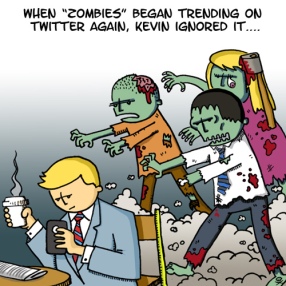 We love the work of Social Media Examiner here at Above The Static, with their most recent feature on WWE‘s adoption of social media just one example of their insightful case studies.
We love the work of Social Media Examiner here at Above The Static, with their most recent feature on WWE‘s adoption of social media just one example of their insightful case studies.
It got us thinking, though, how do the lessons presented from a case such as this apply to us SMB’s, with minimal brand clout and lacking an army of raving fans?
When it comes to social media, the strategies for building an effective brand through web presence development need to be adjusted. The platforms available certainly allow us to compete with the Goliaths of our respective fields but, like David, we still need to pick the right tactics to win.
So let’s look at the take-away points from the aforementioned article, this time from the perspective of a small-medium size business owner:
.
- Go where the fans are
Big brands have already done much of the work to build a fan base through other channels, so naturally their goal in adopting a new medium focuses more heavily on finding this existing group. For smaller organizations, although a dedicated core may exist, it’s more a case of seeking out prospective fans, engaging them, and converting to Ken Blanchard’s Raving Fans. Ideally, your current community will advocate you initially and help to attract the new members to get the ball rolling.
Furthermore, the chance to identify dissatisfied customers of larger brands offers a vital new channel to smaller competitors. By monitoring their social media output and engaging them in discussion, perhaps providing advice or a solution to their issues, we can prove more communicative and flexible than the big boys. Inject a dose of local knowledge that larger names often lack and you’re on the way to leveling the playing field.
- Stick to your story line
SMB’s still need to build their brand and remain on point with their chosen message, so sticking to this with social media content is a similar requirement. The approach certainly differs, however, as a local focus and showing off the advantages of a flexible local company are often key to defining a successful smaller brand. Having your community back up your claims of superior service and better understanding of your area’s needs also goes a long way to growing your social media community. Providing regional content via blogs and shared news items only increases your ability to point to local ties and expertise.
- Protect your identity
Established brands will have to deal with this immediately, as customers view social media as an ideal outlet to complain about their service issues. This is less likely to plague SMB’s initially given the reduced customer base, though the opportunity still exists and getting the required monitoring systems in place early on allows us to address any negative press before it has a chance to spread too far. We wrote more on this subject earlier this year in our Listening Stations post.
The message here for smaller organizations is two-fold: 1) From the very beginning, understand that social media makes communication a two-way street, in which our clients have as much ability to discuss our activities as we do, and 2) Bigger brands are far more susceptible to unhappy customers and, if they’re expressing this dissatisfaction online, you can find and engage them. If done sensitively, with the individual’s needs at the heart of your communication and action, this can be an excellent way to develop new business and position yourself as a preferable, more flexible alternative to your larger competitors.
.
So we can see that although SMB’s will use the same social media tools and platforms as the big brands, we need to approach them from our own angle, advocating the advantages of using smaller providers. This may include the local factor, ability to be more flexible and responsive to the needs of the community, friendlier customer service, or any number of factors that give us greater maneuverability than the big players in our field.
Don’t be discouraged by the daunting success of some large brands using social media. The tools really offer a great opportunity to reach out to new and existing audiences alike, creating a more level playing field using the same platforms. So pick the right battles and bring down Goliath one converted fan at a time!
.
Have you been successful in identifying unhappy customers via social media and addressing their needs?
What other benefits do you think smaller brands offer that the Goliaths of the industry simply can’t keep up with?
.
Photo courtesy of Feeb



 Posted by Steve Birkett
Posted by Steve Birkett 











